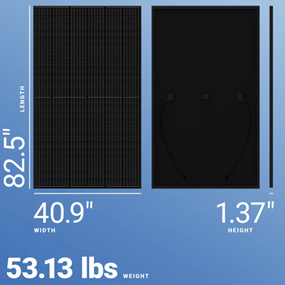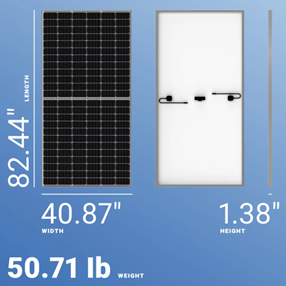Solar panels for greenhouse: Expert review 2023
/Are you a farmer or gardener looking for ways to make your greenhouse more sustainable and efficient? Using solar panels is an effective way to provide your plants with abundant sunlight without relying on electricity from the grid. Solar panels can save you money in the long run by providing a more sustainable and less expensive power source for your greenhouse, while also improving the health of your plants.
One of the most important factors to consider when choosing a solar panel is its compatibility with your existing equipment. You will need to ensure that the panel you choose generates sufficient energy to support your greenhouse’s needs, such as lighting and heating, if necessary. Researching different types of solar panels and what they have to offer is also essential, as it can help you find one that fits within your budget and expectations.
In this expert-reviewed article, we'll explore the top performing solar panels for a greenhouse, highlighting their key features and benefits for growing food and agriculture in any season of the year. From increased crop yields to reduced energy costs, solar panels offer a wide range of benefits for those looking to become more self-sufficient and environmentally friendly. Whether you're a small-scale farmer or a large-scale commercial grower, these top models will help you take your greenhouse to the next level of performance.
Top three solar panels for greenhouse growing
Below we have curated a list of the top 3 solar panels for greenhouse growing based on their technical specifications and performance. These panels have been reviewed by professional engineers and are ranked objectively to help you make an informed decision. Let's take a look at the best solar panels for greenhouses available on the market today.
Aptos DNA 440 W: Double the power
In comparison to a conventional 440 W solar panel, a bifacial module's output can increase by as much as 30%, resulting in a far quicker return on investment than any monofacial panel can provide. What gives this 440 W bifacial panel a potential performance boost is its ability to use both sides to create energy. The energy output of bifacial solar panels increases as they are tilted away from the roof or ground, in contrast to monofacial panels. In order to preserve the energy output of the module's backside, bifacial modules should be installed at a distance of 1 m from the ground or roof. The panels are predicted to last for at least 25 years, and Aptos backs that up with a performance warranty of 30 years. The failure rate of Aptos solar panels is less than 0.01%, therefore you probably won't ever have to use the warranty.
Axitec AXIpremium 450 W: German engineering
If you are unable to produce the ideal circumstances for bifacial modules, opting for a monofacial panel like this one will be the best choice for your solar energy greenhouse. The fact that Axitec offers a product guarantee that is good for 15 years and a performance warranty that is good for 25 years tells a lot about how long the panels are projected to last. Even after 25 years, your Axitec panels will retain at least 85% of the capacity they had when they were first installed.
Mission Solar 380 W: American-made
Mission Solar used 66 PERC solar cells in this 380 W panel. The nicest thing about it is the low cost, considering the tremendous power output and extended lifespan it provides. The model's backsheet and anodized aluminum alloy frame are both jet black, creating a sleek, monochrome appearance. Mission Solar engineered it to endure a snow load of up to 5400 Pa and a wind load of up to 3600 Pa. This US-made panel reaches an efficiency of 19.1%. Because of this and its great dependability, it is a great solar panel for greenhouse of any size.
How many watts does it take to run a greenhouse?
The amount of watts needed for a greenhouse powered by solar panels depends on several factors, including the outside temperature, the type of crop(s) being grown, and the build quality of the greenhouse.
One of the main factors to consider is the outside temperature. In a cold climate, more energy will be needed to maintain the ideal temperature inside the greenhouse, as opposed to a warmer climate where less energy will be required. Additionally, the type of crop being grown also plays a role in determining the amount of energy needed. Certain crops, such as tropical plants, require more energy to maintain the ideal temperature and humidity levels that enable them to thrive.
The build quality of the greenhouse is another important factor to consider. A well-insulated greenhouse will require less energy to maintain the ideal temperature, as opposed to a poorly insulated greenhouse. The efficiency of the greenhouse in retaining heat, using traditional cladding or insulated metal panels for colder climates, will also play a role in determining how much power is needed for a greenhouse that relies on solar panels for its heat source. Ultimately good insulation will help to keep the heat inside during the winter, and the cool air inside during the summer.
like this? Please pin!
As a rough estimate, a small greenhouse of about 200 sq ft, with basic insulation and growing vegetables would need around 1000–1500 watts of solar panel power to operate efficiently. However, it's important to note that this is just an approximation and actual energy consumption can vary depending on the specific factors mentioned above. It's always best to consult with a professional engineer or solar panel installer to determine the exact amount of solar power needed for your greenhouse.
The benefits of using solar panels
Solar panel energy is becoming increasingly popular as an alternate energy source in order to offset energy costs and help reduce our reliance on non-renewable sources of energy. For greenhouse growers, solar panels provide an attractive alternative to generating power, as they can harness the sun’s energy, providing clean and renewable electricity without any of the byproducts created with traditional fossil fuels. Solar panels are also relatively low maintenance and easy to install and take advantage of daylight hours throughout the year. Each of the solar panels we have reviewed in this article provide optimum performance for the greenhouse grower and can ultimately lead to big savings that will pay off relatively quickly.
About the Author:
Maxim Kulik: Writing for electronics manufacturers like Bitmain taught Maxim to extract the important details from lengthy equipment documentation. At the same time, it made him aware of the environmental effects, and he put his talents to work for a renewable future.








































